Accounting for Decision Making: Tesco's Balanced Scorecard Analysis
VerifiedAdded on 2020/04/15
|5
|980
|179
Report
AI Summary
This report examines the application of the balanced scorecard (BSC) by Tesco, a leading UK supermarket chain, to evaluate its strategic performance. The analysis highlights how Tesco utilizes the BSC, referred to as the 'Steering Wheel,' to assess performance across customer, internal, learning, and financial perspectives. The report details Tesco's organizational objectives, measures, and targets within each BSC segment, including customer satisfaction, financial growth, product quality, and employee skills. It evaluates the alignment of Tesco's BSC with its strategic goals, such as driving sales and achieving customer loyalty, and assesses the completeness and consistency of its chosen measures. The study concludes that Tesco's BSC is well-aligned with its strategic plans and stakeholder interests, supporting effective decision-making and continuous improvement in a competitive retail environment.
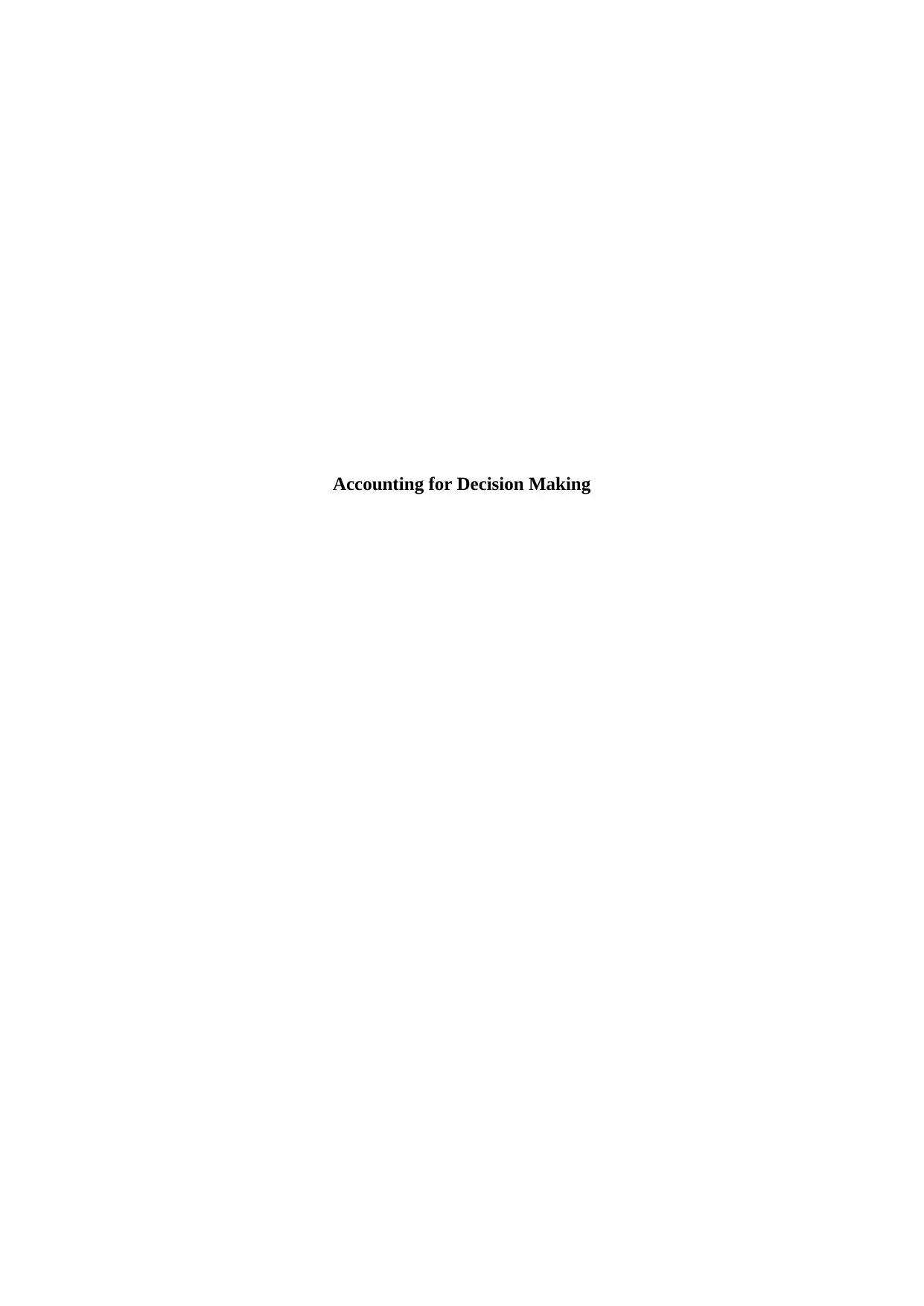
Accounting for Decision Making
Paraphrase This Document
Need a fresh take? Get an instant paraphrase of this document with our AI Paraphraser
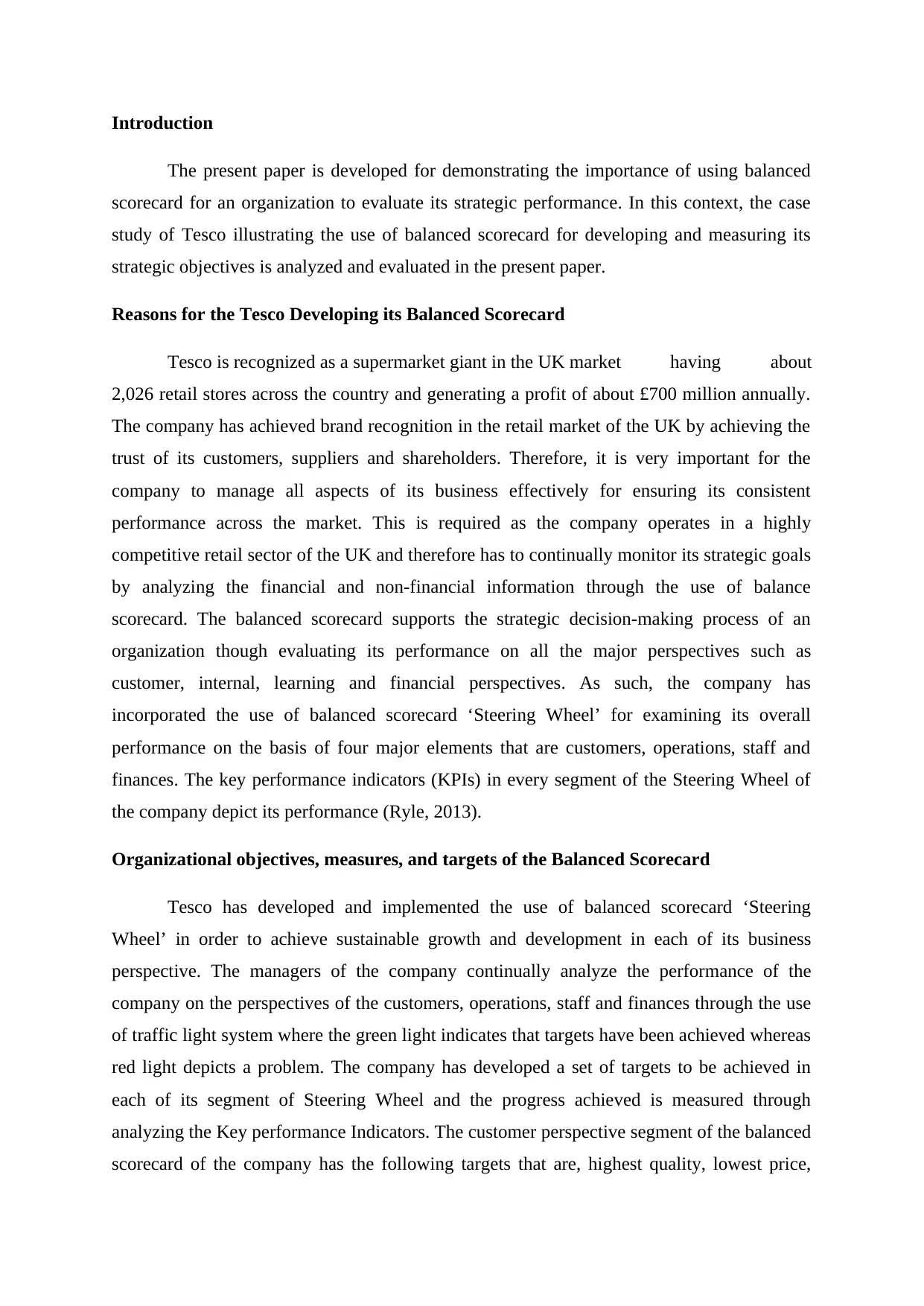
Introduction
The present paper is developed for demonstrating the importance of using balanced
scorecard for an organization to evaluate its strategic performance. In this context, the case
study of Tesco illustrating the use of balanced scorecard for developing and measuring its
strategic objectives is analyzed and evaluated in the present paper.
Reasons for the Tesco Developing its Balanced Scorecard
Tesco is recognized as a supermarket giant in the UK market having about
2,026 retail stores across the country and generating a profit of about £700 million annually.
The company has achieved brand recognition in the retail market of the UK by achieving the
trust of its customers, suppliers and shareholders. Therefore, it is very important for the
company to manage all aspects of its business effectively for ensuring its consistent
performance across the market. This is required as the company operates in a highly
competitive retail sector of the UK and therefore has to continually monitor its strategic goals
by analyzing the financial and non-financial information through the use of balance
scorecard. The balanced scorecard supports the strategic decision-making process of an
organization though evaluating its performance on all the major perspectives such as
customer, internal, learning and financial perspectives. As such, the company has
incorporated the use of balanced scorecard ‘Steering Wheel’ for examining its overall
performance on the basis of four major elements that are customers, operations, staff and
finances. The key performance indicators (KPIs) in every segment of the Steering Wheel of
the company depict its performance (Ryle, 2013).
Organizational objectives, measures, and targets of the Balanced Scorecard
Tesco has developed and implemented the use of balanced scorecard ‘Steering
Wheel’ in order to achieve sustainable growth and development in each of its business
perspective. The managers of the company continually analyze the performance of the
company on the perspectives of the customers, operations, staff and finances through the use
of traffic light system where the green light indicates that targets have been achieved whereas
red light depicts a problem. The company has developed a set of targets to be achieved in
each of its segment of Steering Wheel and the progress achieved is measured through
analyzing the Key performance Indicators. The customer perspective segment of the balanced
scorecard of the company has the following targets that are, highest quality, lowest price,
The present paper is developed for demonstrating the importance of using balanced
scorecard for an organization to evaluate its strategic performance. In this context, the case
study of Tesco illustrating the use of balanced scorecard for developing and measuring its
strategic objectives is analyzed and evaluated in the present paper.
Reasons for the Tesco Developing its Balanced Scorecard
Tesco is recognized as a supermarket giant in the UK market having about
2,026 retail stores across the country and generating a profit of about £700 million annually.
The company has achieved brand recognition in the retail market of the UK by achieving the
trust of its customers, suppliers and shareholders. Therefore, it is very important for the
company to manage all aspects of its business effectively for ensuring its consistent
performance across the market. This is required as the company operates in a highly
competitive retail sector of the UK and therefore has to continually monitor its strategic goals
by analyzing the financial and non-financial information through the use of balance
scorecard. The balanced scorecard supports the strategic decision-making process of an
organization though evaluating its performance on all the major perspectives such as
customer, internal, learning and financial perspectives. As such, the company has
incorporated the use of balanced scorecard ‘Steering Wheel’ for examining its overall
performance on the basis of four major elements that are customers, operations, staff and
finances. The key performance indicators (KPIs) in every segment of the Steering Wheel of
the company depict its performance (Ryle, 2013).
Organizational objectives, measures, and targets of the Balanced Scorecard
Tesco has developed and implemented the use of balanced scorecard ‘Steering
Wheel’ in order to achieve sustainable growth and development in each of its business
perspective. The managers of the company continually analyze the performance of the
company on the perspectives of the customers, operations, staff and finances through the use
of traffic light system where the green light indicates that targets have been achieved whereas
red light depicts a problem. The company has developed a set of targets to be achieved in
each of its segment of Steering Wheel and the progress achieved is measured through
analyzing the Key performance Indicators. The customer perspective segment of the balanced
scorecard of the company has the following targets that are, highest quality, lowest price,
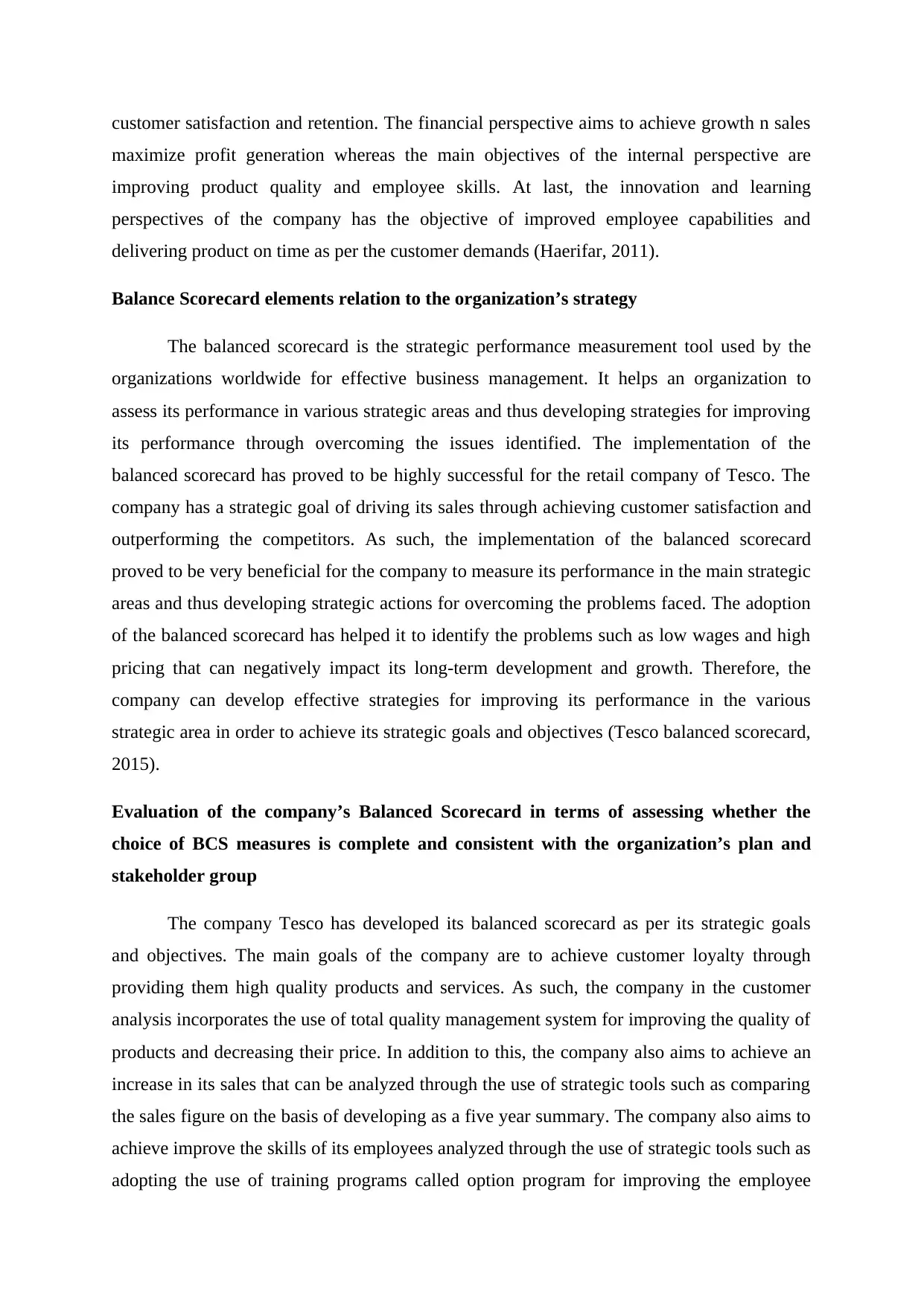
customer satisfaction and retention. The financial perspective aims to achieve growth n sales
maximize profit generation whereas the main objectives of the internal perspective are
improving product quality and employee skills. At last, the innovation and learning
perspectives of the company has the objective of improved employee capabilities and
delivering product on time as per the customer demands (Haerifar, 2011).
Balance Scorecard elements relation to the organization’s strategy
The balanced scorecard is the strategic performance measurement tool used by the
organizations worldwide for effective business management. It helps an organization to
assess its performance in various strategic areas and thus developing strategies for improving
its performance through overcoming the issues identified. The implementation of the
balanced scorecard has proved to be highly successful for the retail company of Tesco. The
company has a strategic goal of driving its sales through achieving customer satisfaction and
outperforming the competitors. As such, the implementation of the balanced scorecard
proved to be very beneficial for the company to measure its performance in the main strategic
areas and thus developing strategic actions for overcoming the problems faced. The adoption
of the balanced scorecard has helped it to identify the problems such as low wages and high
pricing that can negatively impact its long-term development and growth. Therefore, the
company can develop effective strategies for improving its performance in the various
strategic area in order to achieve its strategic goals and objectives (Tesco balanced scorecard,
2015).
Evaluation of the company’s Balanced Scorecard in terms of assessing whether the
choice of BCS measures is complete and consistent with the organization’s plan and
stakeholder group
The company Tesco has developed its balanced scorecard as per its strategic goals
and objectives. The main goals of the company are to achieve customer loyalty through
providing them high quality products and services. As such, the company in the customer
analysis incorporates the use of total quality management system for improving the quality of
products and decreasing their price. In addition to this, the company also aims to achieve an
increase in its sales that can be analyzed through the use of strategic tools such as comparing
the sales figure on the basis of developing as a five year summary. The company also aims to
achieve improve the skills of its employees analyzed through the use of strategic tools such as
adopting the use of training programs called option program for improving the employee
maximize profit generation whereas the main objectives of the internal perspective are
improving product quality and employee skills. At last, the innovation and learning
perspectives of the company has the objective of improved employee capabilities and
delivering product on time as per the customer demands (Haerifar, 2011).
Balance Scorecard elements relation to the organization’s strategy
The balanced scorecard is the strategic performance measurement tool used by the
organizations worldwide for effective business management. It helps an organization to
assess its performance in various strategic areas and thus developing strategies for improving
its performance through overcoming the issues identified. The implementation of the
balanced scorecard has proved to be highly successful for the retail company of Tesco. The
company has a strategic goal of driving its sales through achieving customer satisfaction and
outperforming the competitors. As such, the implementation of the balanced scorecard
proved to be very beneficial for the company to measure its performance in the main strategic
areas and thus developing strategic actions for overcoming the problems faced. The adoption
of the balanced scorecard has helped it to identify the problems such as low wages and high
pricing that can negatively impact its long-term development and growth. Therefore, the
company can develop effective strategies for improving its performance in the various
strategic area in order to achieve its strategic goals and objectives (Tesco balanced scorecard,
2015).
Evaluation of the company’s Balanced Scorecard in terms of assessing whether the
choice of BCS measures is complete and consistent with the organization’s plan and
stakeholder group
The company Tesco has developed its balanced scorecard as per its strategic goals
and objectives. The main goals of the company are to achieve customer loyalty through
providing them high quality products and services. As such, the company in the customer
analysis incorporates the use of total quality management system for improving the quality of
products and decreasing their price. In addition to this, the company also aims to achieve an
increase in its sales that can be analyzed through the use of strategic tools such as comparing
the sales figure on the basis of developing as a five year summary. The company also aims to
achieve improve the skills of its employees analyzed through the use of strategic tools such as
adopting the use of training programs called option program for improving the employee
⊘ This is a preview!⊘
Do you want full access?
Subscribe today to unlock all pages.

Trusted by 1+ million students worldwide
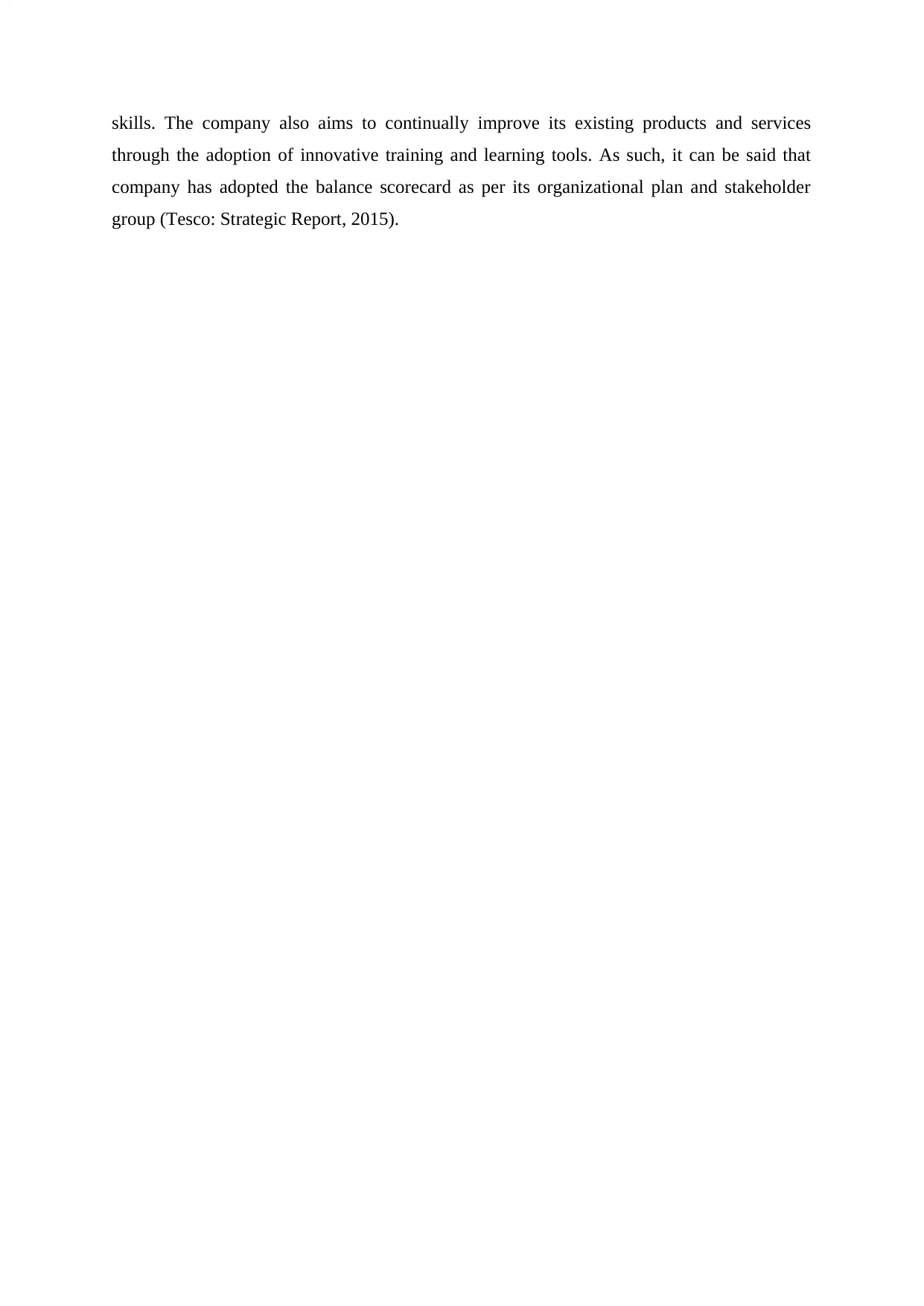
skills. The company also aims to continually improve its existing products and services
through the adoption of innovative training and learning tools. As such, it can be said that
company has adopted the balance scorecard as per its organizational plan and stakeholder
group (Tesco: Strategic Report, 2015).
through the adoption of innovative training and learning tools. As such, it can be said that
company has adopted the balance scorecard as per its organizational plan and stakeholder
group (Tesco: Strategic Report, 2015).
Paraphrase This Document
Need a fresh take? Get an instant paraphrase of this document with our AI Paraphraser
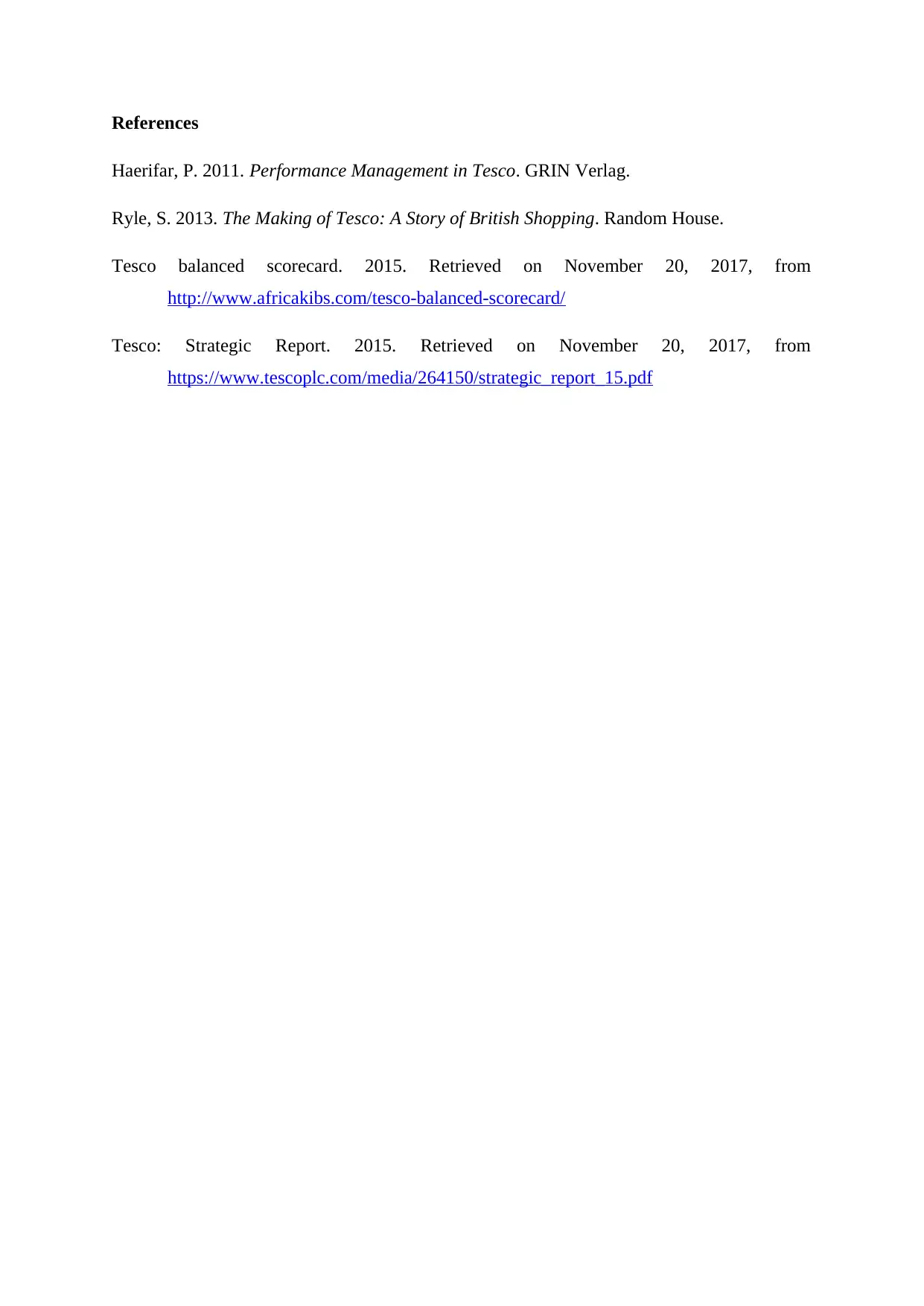
References
Haerifar, P. 2011. Performance Management in Tesco. GRIN Verlag.
Ryle, S. 2013. The Making of Tesco: A Story of British Shopping. Random House.
Tesco balanced scorecard. 2015. Retrieved on November 20, 2017, from
http://www.africakibs.com/tesco-balanced-scorecard/
Tesco: Strategic Report. 2015. Retrieved on November 20, 2017, from
https://www.tescoplc.com/media/264150/strategic_report_15.pdf
Haerifar, P. 2011. Performance Management in Tesco. GRIN Verlag.
Ryle, S. 2013. The Making of Tesco: A Story of British Shopping. Random House.
Tesco balanced scorecard. 2015. Retrieved on November 20, 2017, from
http://www.africakibs.com/tesco-balanced-scorecard/
Tesco: Strategic Report. 2015. Retrieved on November 20, 2017, from
https://www.tescoplc.com/media/264150/strategic_report_15.pdf
1 out of 5
Related Documents
Your All-in-One AI-Powered Toolkit for Academic Success.
+13062052269
info@desklib.com
Available 24*7 on WhatsApp / Email
![[object Object]](/_next/static/media/star-bottom.7253800d.svg)
Unlock your academic potential
Copyright © 2020–2025 A2Z Services. All Rights Reserved. Developed and managed by ZUCOL.





